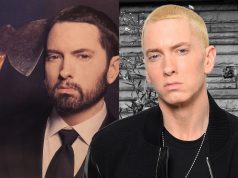Eminem’s “Stan” remains arguably the most powerful and captivating story ever told in hip hop. To start a sequel to “Marshal Mathers LP” with a sequel to “Stan” was a bold decision. Did Eminem execute his plans and take the story where he wanted to?
These are the questions that HNHH’s Mitch Findlay asked and answered in his piece about Eminem’s “Bad Guy”.
He states from the start that “Bad Guy” is a crucially underrated track that nevertheless bears all signs of Em’s lyrical genius. On a surface, it presents the story of Stan’s younger brother Matthew who kidnaps the rapper to make him pay for everything he did to Matthew’s family, the story that brings both of them to the end that perfectly mirrors the one of the original song: the car shoots off the bridge in a chase with Em locked in the trunk. The same topics of fanatical obsession and revenge are in the focus of the narration.
However, the second part of the song goes deeper, notices the author:
Though it could be argued that Eminem’s final verse symbolizes his life flashing before his eyes, which certainly works on a narrative level, it feels like its message is meant to stand on its own. Forgetting about the continuation of the “Stan” story for a moment, these final moments circle back to themes Em has often grappled with. That of a guilty conscience, specifically his own; we’ve seen him use this framework before, most notably on the Relapse bonus track “My Darling.” There’s plenty of self-loathing to go around, with each bar framed as a flaw, be it his hypocrisy, his willing denial, or his aging physicality. He even goes so far as to shatter the fourth wall, telling himself that “Matthew and Stan are just symbolic of you not knowing what you had till it’s gone,” a line that deserves closer examination.
On the surface, both Matthew and Stan were die-hard fans of Eminem’s music, though both were ultimately moved to violence and homicidal insanity. Regardless of the consequences, Em seems to acknowledge that he took their love for granted and now must face the music.
The article draws the conclusion that decision to start the album with this particular song reflected Marshall’s stance on his place in the world as an artist in general. Offering a sequel to one of the most beloved albums in history while having left the life it was written in behind, Eminem assumed his responsibilities as a creator and got ready to face consequences:
Em clearly understands the expectations associated with his music, having frequently alluded to it across various records, and remains haunted by the possibility of falling short. It’s a conundrum, as an artist should feel free to create beyond the microscope’s unfaltering gaze. Yet Eminem understands his own impact and feels like anything less than perfection will be a betrayal of his classic music. “If there’s anything you have left to say, less it makes an impact, then don’t bother,” he tells himself. “So before you rest your case, better make sure you’re packin’ a wallop.” A fair assessment, and one that highlights the pressure of living up to one of his career-defining songs. No matter where you stand on “Bad Guy,” Eminem deserves appreciation for even attempting to continue the story in the first place.
Read the article in full on HotNewHipHop












